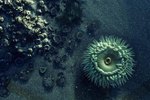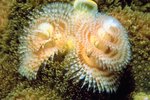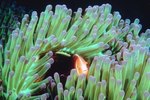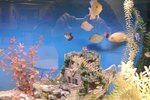
Many oceanic creatures are still a bit of a mystery to scientists and that includes the yellow tube sponge, also known as Aplysina fistularis. Sea sponges may look like plants, but they are actually animals that attach themselves to the sea floor and live on plankton or other substances that they filter from the water.
Appearance
The creature’s name is an indication of what it looks like. Yellow tube sponges have the shape of a long, hollow tube and can be as long as 3 feet. In shallow water they are bright yellow, while deeper-water tube sponges are darker in color. When a yellow tube sponge is exposed to air, it begins to turn purple and then black. A single sponge is actually made up of several tubes that are connected at the base, where they attach themselves to the ocean floor.
Habitat
Yellow tube sponges live on reefs and are common in the Caribbean, Florida and the Gulf of Mexico. They are typically found at depths of less than 100 feet. Because of their diet, they thrive in areas with a strong current.
Diet
Yellow tube sponges are filter feeders, which means that they take in ocean water through their tubes and extract plankton, bacteria, and dead organic material to consume. Tiny hair-like structures on the inside of the sponge keep the water circulating. This movement is very efficient. Every minute the sponge pumps an amount of water that equals five times its volume.
Survival and Defense
If you were observing a sponge, you might not notice a lot of action. Because these animals are attached to the sea floor, they don’t move very much. However, even sponges have ways of defending themselves from predators. Yellow tube sponges produce chemicals that give them an unpleasant flavor and prevents other creatures, like algae and barnacles, from attaching to their tubes.
One of the most amazing behaviors of yellow sponges happens when they are knocked over. Although they cannot really move on their own, the creatures will actually rearrange their cells to create an upright tube.
More Fun Facts
Yellow tube sponges can reproduce both sexually and asexually. Not only does each animal have both male and female organs, but if part of the sponge is cut off, it will grow to form a new sponge.
Some studies have shown that yellow tube sponges produce chemicals that have antimicrobial properties. If this property can be exploited for human use, it might mean less use of toxic antimicrobials in the future.
References
Photo Credits
-
Photodisc/Digital Vision/Getty Images
Writer Bio
Kimberly A. Smith has been a freelance writer for two years. She graduated from the University of California at Davis and the California Culinary Academy, then pursued a career baking wedding cakes. During her time at CCA, she received certification in nutrition and food safety. She currently attends the University of Oregon School of Law.




